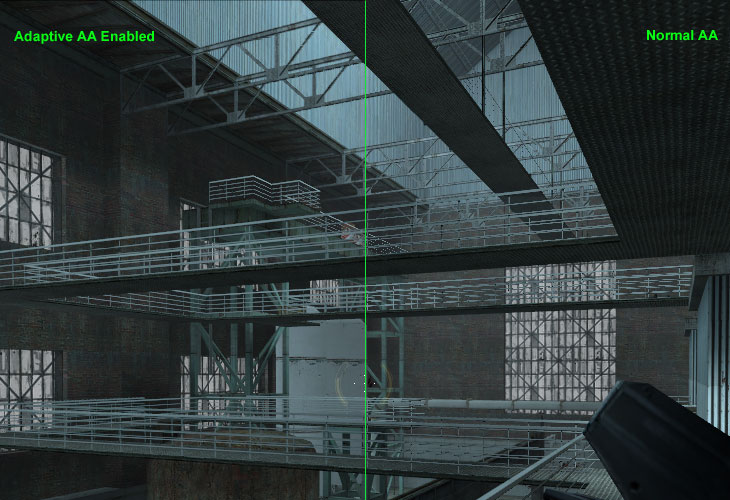
While we were expecting ATI's upcoming R520 GPU to have some form of Transparency Anti-Aliasing, we didn't expect it to come before then on the products derrived from R420.
However, the bright sparks over at Beyond3D forums seem to have cracked the code in order to get what ATI are calling Adaptive Anti-Aliasing working on the current generation of Radeon X800 series video cards with the recently released Catalyst 5.9 display driver.
The feature needs to be unlocked via a registry hack and can result in some quite outstanding improvements in image quality. You can read about how to enable the hack here.
So, what does this do for performance?
Well, according to the forum member who managed to unlock this feature, there was a 10fps difference between the two modes in the screenshots in this post. We have created a comparison shot by taking half of each image and stitching them together - you can see the differences below.
The performance drop is much greater than what is experienced with GeForce 7-series. However, we suspect that the performance implications will be removed when R520 is released.
 To be blunt - wow... just wow! The differences are massive as I'm sure you can see - I'm pretty speechless right now.
To be blunt - wow... just wow! The differences are massive as I'm sure you can see - I'm pretty speechless right now.
We believe that the reason for ATI calling it Adaptive Anti-Aliasing is that it depends on whether the texture is made bigger or smaller than its default size. We say this because some parts of the scene appear to be SuperSampled, while other parts scene appear to be using what is commonly known as transparency Anti-Aliasing, as introduced with NVIDIA's GeForce 7-series.
We'll be doing some of our own investigations over the next week or so. Until then, discuss these developments in the forums.
However, the bright sparks over at Beyond3D forums seem to have cracked the code in order to get what ATI are calling Adaptive Anti-Aliasing working on the current generation of Radeon X800 series video cards with the recently released Catalyst 5.9 display driver.
The feature needs to be unlocked via a registry hack and can result in some quite outstanding improvements in image quality. You can read about how to enable the hack here.
So, what does this do for performance?
Well, according to the forum member who managed to unlock this feature, there was a 10fps difference between the two modes in the screenshots in this post. We have created a comparison shot by taking half of each image and stitching them together - you can see the differences below.
The performance drop is much greater than what is experienced with GeForce 7-series. However, we suspect that the performance implications will be removed when R520 is released.

We believe that the reason for ATI calling it Adaptive Anti-Aliasing is that it depends on whether the texture is made bigger or smaller than its default size. We say this because some parts of the scene appear to be SuperSampled, while other parts scene appear to be using what is commonly known as transparency Anti-Aliasing, as introduced with NVIDIA's GeForce 7-series.
We'll be doing some of our own investigations over the next week or so. Until then, discuss these developments in the forums.

MSI MPG Velox 100R Chassis Review
October 14 2021 | 15:04





Want to comment? Please log in.